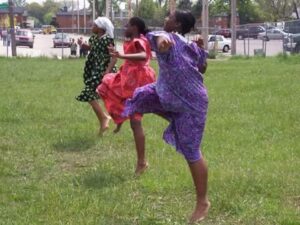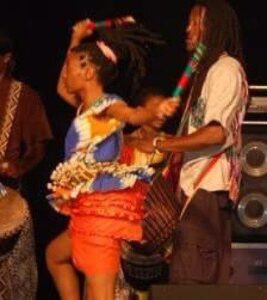
Yankadi-Makru: a courtship dance
Oh, African dance is just so incredibly unremarkable. If you’ve done one dance- you’ve done them all. I mean, who needs the rich tapestry of diverse cultures, traditions, and histories that have shaped the continent and beyond for millennia? It’s not like African dance embodies a vibrant celebration of life, spirituality, and community, all expressed through intricate rhythms, mesmerizing body movements, and colorful garments.
And don’t even get me started on the sheer audacity of African dance’s ability to convey stories, emotions, and social commentary through every graceful step and powerful gesture. Who needs that kind of artistic depth and cultural significance anyway?
In all seriousness, African dance is unique precisely because of its diversity and its ability to reflect the vast array of cultural elements and traditions across the continent. It’s a beautiful testament to the richness of human expression and the enduring power of tradition.

Ekon Kon dance with sticks
African dance is definitely diverse within the continent and throughout the diaspora, but there are some common elements and characteristics often found in African dance traditions throughout the diaspora. Here are ten of them:
- Rhythm and Percussion: African dance is known for its strong emphasis on rhythm and percussion instruments like drums, rattles, and xylophones. Rhythms often drive the movements and are central to the dance experience.
- Polycentrism: African dance frequently incorporates polycentric movements, which means that different parts of the body move independently and rhythmically. This creates a complex and dynamic visual and kinetic, polyrhythmic experience.
- Isolation/African dance Vocabulary: African dancers often isolate and emphasize specific body parts, such as the hips, wrists, shoulders, or feet. This allows for intricate and expressive movements.
- Earth Orientation: African dance typically involves movements that are close to the ground, with dancers frequently bending their knees and hips, giving a sense of connection to the earth.
- Storytelling: Many African dances are used as a form of storytelling, conveying narratives, folklore, or historical events through choreography, pantomime and symbolism.
- Community and Social Expression: African dance is often a communal activity, with audience/participants coming together to celebrate, communicate, and express their cultural identity. It’s a way of fostering a sense of belonging and unity.
- Call-and-Response: In many African dance traditions, there’s a call-and-response element where a lead dancer or drummer initiates movements or rhythms, and others respond. This interaction enhances the communal aspect of the dance. Oseye! Ye-ye! Agoooo? Ameeee!
- Garments and Attire: Elaborate attire is common in African dance, often reflecting the cultural and ceremonial significance of the dance. These garments can include colorful fabrics, masks, beadwork, jewelry, etc.
- Spiritual and Ritualistic Elements: African dance frequently has spiritual and ritualistic dimensions, whether it’s a part of spiritual ceremonies, rites of passage, or other cultural practices.
- Innovation and Adaptation: African dance is not static; it evolves and adapts over time. Dancers and choreographers incorporate new elements, fuse different styles, and respond to changing cultural contexts.
Watch this clip from African dance class.
These African dance characteristics can vary significantly across the African continent due to its vast diversity of cultures and traditions. Each region and ethnic group will have unique dance expressions. Preserving African dance and culture is not just a matter of heritage but also an essential aspect of promoting cultural diversity, fostering community cohesion, and supporting artistic and economic development. It allows for the continuation of vibrant tradition that is integral to the world’s cultural landscape.
- African Dance: An Artistic, Historical and Philosophical Inquiry, Kariamu Welsh-Asante; Third World Press, 2000